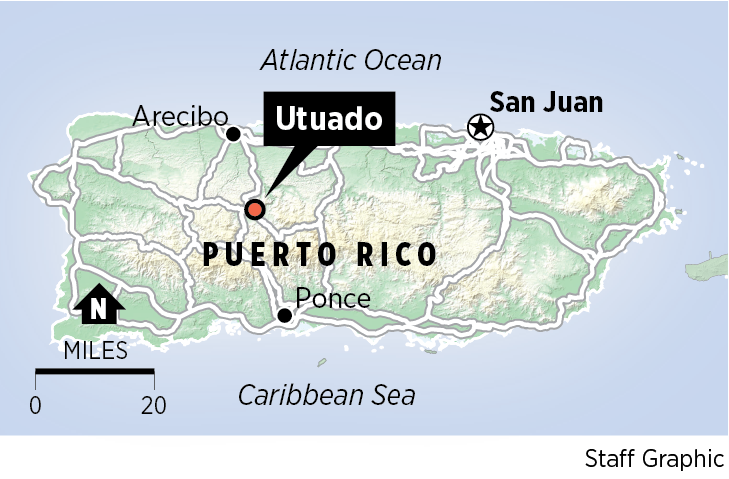At Puerto Rico's 'Camp of the Forgotten'
In Utuado, Puerto Rico, an orange shopping cart hovers above the river, swaying from a cable that stretches where a concrete bridge once did. The homemade pulley system has been this community's means of survival since Hurricane Maria wiped away the bridge On Thursday morning, 39-year-old Elias Fresse loaded a suitcase and a bag of clothes into the basket, then carefully descended about 50 feet down a wooden ladder to the river's floor, which thankfully was dry that day. The plush Minnie Mouse toy tied to his backpack was a surprise for his 3-year-old daughter Valerie.
/arc-anglerfish-arc2-prod-pmn.s3.amazonaws.com/public/BGG5E5XIERCUZJDONCETWWMQGE.jpg)
UTUADO, Puerto Rico — An orange shopping cart hovers above the river, swaying from a cable that stretches where a concrete bridge once did.
On Thursday morning, 39-year-old Elias Fresse loaded a suitcase and a bag of clothes into the basket, then carefully descended about 50 feet down two wooden ladders to the river's bed, which was mostly dry. The plush Minnie Mouse tied to his backpack was a surprise for his 3-year-old daughter, Valerie.
"I've been doing this for two weeks now," Fresse said, his rain boots coated in mud from the hour-long hike each way through dense woods and downed trees to his family's home. "Every three days I go out."
As Puerto Rico continues its slow recovery from Hurricane Maria, this is a community cut off. Campamento de los Olvidados, "Camp of the Forgotten," reads a sign neighbors posted at the edge of the bridge, the nickname they gave their community after the storm.
For weeks, the homemade pulley system has been their means of survival, the way to get the food and water deliveries that started arriving two weeks after the storm.
But on Thursday, there was a new reason to be hopeful. The government's public water utility is constructing a bridge a half-mile upstream, and rumors that it would be only accessible to the agency's own vehicles had turned out to be just rumors.
 “It’s not true. It’s fake news,” said Marilyn Luciano Soto, 47, who said she met with the project’s engineer Wednesday.
“It’s not true. It’s fake news,” said Marilyn Luciano Soto, 47, who said she met with the project’s engineer Wednesday.
That means cars could soon be traveling again across the Rio Abajo. It would be a significant step but far from the last. Even travel on the accessible side of the bridge is treacherous.
There, the mountain hugs the river, the slopes slashed like wound marks where landslides occurred. That threat remains. The roads are stained burnt orange, the color of mud, or scarred with deep craters that filled with water. Trees and wires crane over cars that pass beneath.
On Thursday, a working bridge was a distant possibility as people made their trips.
Elena Guzman, 44, and her mother, Anna Oquendo, 71, crossed the river for a doctor's appointment, Guzman's fifth in two weeks to treat a stomach virus.
Carlos Ocasio, 61, who created the shopping-cart system with cable he took from a friend and a pulley bought at a Home Depot, crossed with five 5-gallon cans to bring back gasoline for the generator that is powering his home and two neighbors'.
Iliamar Medina, 17, crossed to escape.
"I've been accustomed to what's happening," she said before hopping into the car of a family friend who was taking her to Caguas, about two hours away. "But I need a break."
Medina said her family is surviving, though she worries about her mother, who has severe asthma. If she has a bad attack, Medina said, there is no way to take her to a hospital.
Though many have made the crossing more than a dozen times and seem undaunted, the journey is undeniably dangerous. The first ladder down, made from scraps of wood gathered after the storm, is wedged into a towering pile of brush. To get up on the other side, one must pull oneself up holding the metal caging of the bridge's retaining wall.
Some days it rains, and the journey becomes impossible.
On three occasions, Renaldo Rodriguez, 47, Luciano Soto's husband, traveled across only to find rushing waters when he returned. He slept those nights in his car, the home with the yellow roof and matching porch he shares with his wife just across the river.
She is too scared to cross.
Luciano Soto said she had watched from her home as the rising waters rushed over the bridge, then lifted it and flung it downstream.
"That was the most horrible thing I'd ever seen," she said. "I thought, how the hell am I going to get out of here? That's my only entrance and exit."
She crossed once, but before the river had subsided, wading into the chest-deep water and holding onto a cord tied to the other side. It left her "traumatized," she said.
Now she will keep to her side until a bridge is built.
Fresse won't stay to see that happen. On Tuesday, he will board a flight with his wife and daughters for Virginia, where he has family, leaving behind the concrete house in the mountains he built with his own hands.
He doesn't know if they will come back.
"I've been thinking about it for a whole month. … This island is awesome," he said. "But I think about the girls."